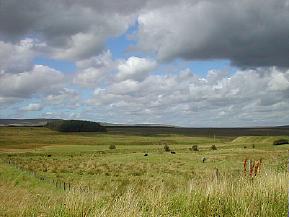Location and Access
 This large tract of upland moor (NS 61 25) is an important ornithological site lying to the south of the upper reaches of the River Ayr. It is bounded by the A70 Cumnock-Muirkirk trunk road on the south and and the B743 on the north.
This large tract of upland moor (NS 61 25) is an important ornithological site lying to the south of the upper reaches of the River Ayr. It is bounded by the A70 Cumnock-Muirkirk trunk road on the south and and the B743 on the north.
 It is possible to get into the Moss on foot from Auchinleck, Cumnock, Cronberry and Muirkirk, all of which are on regular bus routes and there are plans for a footpath in the north-eastern section beside the River Ayr. Some of the byways can be explored, with care, by cycle and there are one or two spots which can be easily investigated on foot.
It is possible to get into the Moss on foot from Auchinleck, Cumnock, Cronberry and Muirkirk, all of which are on regular bus routes and there are plans for a footpath in the north-eastern section beside the River Ayr. Some of the byways can be explored, with care, by cycle and there are one or two spots which can be easily investigated on foot.
Essentially, however, viewing is from one of the major or minor roads around the site. A large layby to the north east of Cronberry on the A70 provides a strategic overview and the byway into the Moss just south east of Cronberry has good vantage points. A short distance along this road (on the left as you head towards Auchinleck), is Common Loch (NS 59 22). This small loch holds a good variety of breeding and wintering birds and is worth checking out at any time of the year. Attention should also be paid to the surrounding area of scrub woodland – a Great Grey Shrike turned up at nearby Commondyke Farm (NS 578 225) a couple of winters ago. Please be alert to the opencast coal mining traffic in the vicinity. A number of wayside stops can be found on the B743 Sorn-Muirkirk road with good birding on both sides, e.g. the bridge over the Greenock Water at NS 631 272.
![]() Park and scan from vehicle.
Park and scan from vehicle.
![]() The A70 requires great care. Some byways also carry mining traffic.
The A70 requires great care. Some byways also carry mining traffic.
Birds
There are many interesting moorland species breeding here including Hen Harrier, Merlin, Red Grouse, Golden Plover, Dunlin and Curlew. Peregrine have been seen and good numbers of Short-eared Owl when the vole numbers are strong. Black Grouse have been observed close to the Sorn-Muirkirk road. Skylark, Tree Pipit, Lesser Redpoll, Stonechat, Whinchat, Wheatear, Common Crossbill, Mistle Thrush, and Reed Bunting are among the other species which are likely to be encountered during a summer visit to the area. In winter, there are always large flocks of thrushes and plenty of ducks and swans to be seen on the small lochs.
Conservation Issues
The area has opencast coal mining potential which gives rise to conflicts of interest between commercial and ecological considerations. Hopefully, compromise and agreement will preserve the moss as a major ornithological site in East Ayrshire.